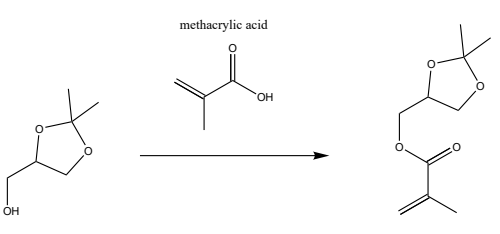(2,2-Dimethyl-1,3-dioxolan-4-yl)methylmethacrylat
|
|
|
- CAS-Nr.
- 7098-80-8
- Bezeichnung:
- (2,2-Dimethyl-1,3-dioxolan-4-yl)methylmethacrylat
- Englisch Name:
- Solketal methacrylate
- Synonyma:
- GMAK;IPGMA;Bisomer IPGMA;IPGMA cas 7098-80-8;Solketal methacrylate;Solketal methacrylate 95%;Bisomer IPGMA cas 7098-80-8;Solketal methacrylate (IPGMA);methacrylate monomer cas 7098-80-8;Solketal methacrylate cas 7098-80-8
- CBNumber:
- CB0938440
- Summenformel:
- C10H16O4
- Molgewicht:
- 200.23
- MOL-Datei:
- 7098-80-8.mol
|
(2,2-Dimethyl-1,3-dioxolan-4-yl)methylmethacrylat Eigenschaften
- Siedepunkt:
- 275℃
- Dichte
- 1.028
- Dampfdruck
- 4Pa at 20℃
- Brechungsindex
- n20/D1.438
- Flammpunkt:
- 116℃
- storage temp.
- -20°C
- Aggregatzustand
- liquid
- InChI
- InChI=1S/C10H16O4/c1-7(2)9(11)12-5-8-6-13-10(3,4)14-8/h8H,1,5-6H2,2-4H3
- InChIKey
- JPFPDGRVRGETED-UHFFFAOYSA-N
- SMILES
- C(OCC1COC(C)(C)O1)(=O)C(C)=C
- EPA chemische Informationen
- (2,2-Dimethyl-1,3-dioxolan-4-yl)methyl methacrylate (7098-80-8)
Sicherheit
- Risiko- und Sicherheitserkl?rung
- Gefahreninformationscode (GHS)
| Bildanzeige (GHS) |
   
|
| Alarmwort |
Achtung |
| Gefahrenhinweise |
| Code |
Gefahrenhinweise |
Gefahrenklasse |
Abteilung |
Alarmwort |
Symbol |
P-Code |
| H226 |
Flüssigkeit und Dampf entzündbar. |
Entzündbare Flüssigkeiten |
Kategorie 3 |
Warnung |
|
|
| H315 |
Verursacht Hautreizungen. |
Hautreizung |
Kategorie 2 |
Warnung |
![GHS hazard pictograms]() src="/GHS07.jpg" width="20" height="20" /> src="/GHS07.jpg" width="20" height="20" /> |
P264, P280, P302+P352, P321,P332+P313, P362 |
| H318 |
Verursacht schwere Augensch?den. |
Schwere Augensch?digung |
Kategorie 1 |
Achtung |
![GHS hazard pictograms]() src="/GHS05.jpg" width="20" height="20" /> src="/GHS05.jpg" width="20" height="20" /> |
P280, P305+P351+P338, P310 |
| H335 |
Kann die Atemwege reizen. |
Spezifische Zielorgan-Toxizit?t (einmalige Exposition) |
Kategorie 3 (Atemwegsreizung) |
Warnung |
![GHS hazard pictograms]() src="/GHS07.jpg" width="20" height="20" /> src="/GHS07.jpg" width="20" height="20" /> |
|
| H336 |
Kann Schl?frigkeit und Benommenheit verursachen. |
Spezifische Zielorgan-Toxizit?t (einmalige Exposition) |
Kategorie 3 (Schl?frigkeit und Benommenheit) |
Warnung |
|
P261, P271, P304+P340, P312,P403+P233, P405, P501 |
| H351 |
Kann vermutlich Krebs verursachen. |
Karzinogenit?t |
Kategorie 2 |
Warnung |
|
P201, P202, P281, P308+P313, P405,P501 |
|
| Sicherheit |
| P202 |
Vor Gebrauch alle Sicherheitshinweise lesen und verstehen. |
| P210 |
Von Hitze, hei?en Oberfl?chen, Funken, offenen Flammen und anderen Zündquellenarten fernhalten. Nicht rauchen. |
| P280 |
Schutzhandschuhe/Schutzkleidung/Augenschutz tragen. |
| P303+P361+P353 |
BEI BERüHRUNG MIT DER HAUT (oder dem Haar): Alle kontaminierten Kleidungsstücke sofort ausziehen. Haut mit Wasser abwaschen oder duschen. |
| P305+P351+P338 |
BEI KONTAKT MIT DEN AUGEN: Einige Minuten lang behutsam mit Wasser spülen. Eventuell vorhandene Kontaktlinsen nach M?glichkeit entfernen. Weiter spülen. |
| P308+P313 |
BEI Exposition oder falls betroffen: ?rztlichen Rat einholen/?rztliche Hilfe hinzuziehen. |
|
(2,2-Dimethyl-1,3-dioxolan-4-yl)methylmethacrylat Chemische Eigenschaften,Einsatz,Produktion Methoden
Chemische Eigenschaften
Colorless liquid
Verwenden
Solketal methacrylate is an acrylate monomer with used in adhesives.
synthetische
Solketal methacrylate (SMA) (the precursor monomer for GMA), synthesized by reacting solketal with methacryloyl chloride, was polymerized under typical ATRP conditions with THF as the solvent at 40 °C, employing the synthesized POSS based initiator, and CuCl/N,N,N,N,N-pentamethyldiethylenetriamine as the catalyst system.

Chemical scheme for the production of Solketal Methacrylate
Amphiphilic tadpole-shaped POSS-poly(glycerol methacrylate) hybrid polymers: synthesis and self-assembly.
Source: Journal of Polymer Research . Jan2019, Vol. 26 Issue 1, p1-1. 1p.
Author(s): Ullah, Asad; Shah, Syed Mujtaba; Hussain, Hazrat
(2,2-Dimethyl-1,3-dioxolan-4-yl)methylmethacrylat Upstream-Materialien And Downstream Produkte
Upstream-Materialien
Downstream Produkte
(2,2-Dimethyl-1,3-dioxolan-4-yl)methylmethacrylat Anbieter Lieferant Produzent Hersteller Vertrieb H?ndler.
Global( 72)Lieferanten
- (2,2-dimethyl-1,3-dioxolan-4-yl)methyl methacrylate
- Glycerine-1-Methacrylate Acetone Ketal
- (2,2-Dimethyl-1,3-dioxolan-4-yl)methylmethacrylat
- 2,3-Isopropylideneglycol methacrylate
- 2,2-Dimethyl-1,3-dioxolane-4-methanol methacrylate
- 2-Methylpropenoic acid (2,2-dimethyl-1,3-dioxolan-4-yl)methyl ester
- Methacrylic acid 2,2-dimethyl-1,3-dioxolane-4-ylmethyl ester
- Methacrylic acid (2,2-dimethyl-1,3-dioxolan-4-yl)methyl ester
- Solketal methacrylate
- (2,2-diMethyl-1,3-dioxolan-4-yl)Methyl Methacrylate (GMAK)
- GMAK
- 2-Propenoic acid, 2-methyl-, (2,2-dimethyl-1,3-dioxolan-4-yl)methyl ester
- (2,2-dimethyl-1,3-dioxolan-4-yl)methyl 2-methylprop-2-enoate
- Solketal methacrylate 50 wt. % in dichloromethane, contains ~280 ppm 4-tert-Butylcatechol as inhibitor
- methacrylate monomer cas 7098-80-8
- IPGMA
- Solketal methacrylate cas 7098-80-8
- Isopropylideneglycerol Methacrylate
- Bisomer IPGMA
- Bisomer IPGMA cas 7098-80-8
- Solketal methacrylate 95% cas 7098-80-8
- Solketal methacrylate 95%
- Bisomer IPGMA (Isopropylideneglycerol Methacrylate)
- Isopropylideneglycerol Methacrylate (IPGMA)
- Isopropylideneglycerol Methacrylate cas 7098-80-8
- Solketal methacrylate (IPGMA)
- IPGMA cas 7098-80-8
- Solketal methacrylate (Bisomer IPGMA)
- 7098-80-8

